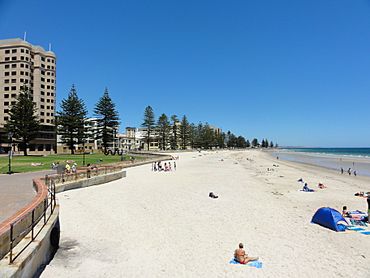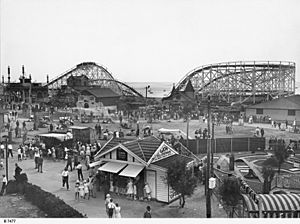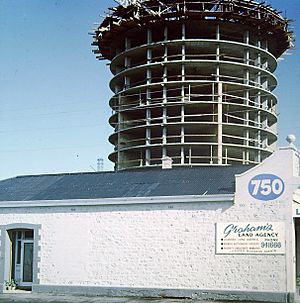Glenelg, South Australia facts for kids
Quick facts for kids GlenelgAdelaide, South Australia |
|||||||||||||||
|---|---|---|---|---|---|---|---|---|---|---|---|---|---|---|---|

Glenelg Beach in summer
|
|||||||||||||||
| Established | 1836 | ||||||||||||||
| Postcode(s) | 5045 | ||||||||||||||
| Area | 0.88 km2 (0.3 sq mi) | ||||||||||||||
| Location |
|
||||||||||||||
| LGA(s) | City of Holdfast Bay | ||||||||||||||
| State electorate(s) | Morphett | ||||||||||||||
| Federal Division(s) | Boothby | ||||||||||||||
|
|||||||||||||||
| Footnotes | Adjoining suburbs | ||||||||||||||
Glenelg is a popular beach town in South Australia. It is located on the coast of Holdfast Bay, which is part of Gulf St Vincent. Glenelg is a favorite spot for tourists. It has a beautiful beach, many hotels, and lots of restaurants.
Glenelg was founded in 1836. This makes it the oldest European settlement on mainland South Australia. It was named after Lord Glenelg. He was an important member of the British government. The name "Glenelg" comes from a place in Scotland.
Contents
History of Glenelg
Before 1836, the Kaurna Aboriginal group lived in the Glenelg area. They called this place "Pattawilya". The local river was known as "Pattawilyangga". Today, it is called the Patawalonga River. Sadly, many Kaurna people died from diseases before 1836.
Long ago, there were huge oyster reefs near Glenelg. These reefs were full of Australian flat oysters. Oysters were a very important food source for Indigenous Australians. After European settlers arrived, many reefs were destroyed. This happened because of oyster fishing and dredging.
Early Settlement
The first British settlers arrived in South Australia in 1836. They looked at a few places before choosing the Adelaide plains. Governor John Hindmarsh officially announced the new province of South Australia. This happened in Glenelg North on 28 December 1836.
Glenelg's first post office opened in 1849. A telegraph office opened in 1859. These two offices joined together in 1868. The current post office building was built in 1912. It is located on Moseley Square.
The land in Glenelg was sold in 1839. A group of six people bought most of the land. Early public buildings included churches and the Pier Hotel. These were built by Henry J. Moseley. Moseley Street and Moseley Square are named after him.
The town of Glenelg became its own local government area in 1855. This meant it was separate from nearby councils. The Glenelg Town Hall was built starting in 1875. It opened in 1877 with lecture rooms and a library. The building was designed by Edmund William Wright. He also designed the Adelaide Town Hall. Today, the Glenelg Town Hall has a museum and tourist information.
Glenelg Jetty
The first jetty in Glenelg started being built in 1857. It opened in 1859. This jetty was 381 meters (1,250 feet) long. It was used by fishermen and ships. It also had a mail service. Later, Port Adelaide became the main port. People could also travel to Kangaroo Island from the jetty.
Over time, more things were added to the jetty. A lighthouse was built in 1872. There were also public baths and an aquarium. A three-story kiosk with tea rooms was also added. None of these original additions are still there.
A big storm damaged the jetty kiosk in 1943. Then, a cyclone severely damaged the jetty in 1948. Most of it washed away. The remaining parts were unsafe. A new jetty was built and finished in 1969. This new jetty is 215 meters (705 feet) long. It is still standing today at the end of Jetty Road.
In 2016, two boys sadly drowned after falling into the water. This happened from rocks north of the jetty.
The Glenelg Blocks
In the early 1900s, there was a plan to build a breakwater. This was meant to create a safe harbor for boats. The project faced many problems. Rough seas damaged machinery. Concrete piles broke when they were put into the ground. By 1919, the project was not finished. It did not create the safe harbor they wanted.
Today, these structures are worn down by the sea. They are covered with marine life. Divers and snorkelers know the site as "The Blocks". It is also called "The Glenelg Blocks". It acts as an artificial reef.
Amusement Parks in Glenelg

Glenelg has always been a fun place for people. In 1930, an amusement park called Luna Park Glenelg opened. It was similar to Luna Park in Melbourne. However, it closed in 1934. Most of its rides were moved to Luna Park Sydney. The park managers said they couldn't make enough money.
Later, Magic Mountain opened in 1982. It was built near the old Luna Park site. Magic Mountain had water slides, mini-golf, and bumper cars. It was very popular with young people. Some people thought it looked ugly. But kids and teenagers loved it.
Magic Mountain was taken down in 2004. It was replaced by The Beachouse in 2006. The Beachouse is a modern, five-story center. It still has the historic carousel. The Beachouse is a very popular attraction in Glenelg. It is fun for both adults and children.
Water Treatment Plant
Glenelg has a large water treatment plant. It is the second biggest in South Australia. It first opened in 1933. The plant has been updated many times. It cleans wastewater. Then, it pumps this treated water to Adelaide. This water is used to water parks and sports fields. The plant also offers tours for school groups. They can learn about water supply and treatment. Some treated water is also returned to the ocean.
Tall Buildings
The Atlantic Tower was built in the late 1970s. It was the tallest residential building in Adelaide at the time. It has fourteen floors. The top floor used to have a spinning restaurant. Many other tall buildings are in Glenelg. These include the Stamford Grand hotel, built in 1990. The Liberty Towers, built in 2004, is also a tall building.
The Holdfast Shores project started in the late 1990s. It added more apartments and a private marina. It also included the Pier Hotel. Many local people did not like this development. They worried it would make the area too crowded. Some parts of the plan were made smaller.
People of Glenelg (Demographics)
In 2016, about 3,349 people lived in Glenelg. Most residents have European backgrounds. Nearly two-thirds of the people are at least second-generation Australians. Glenelg is mostly a Christian community. The most common religions are Catholic and Anglican.
The people in Glenelg are generally older than the average Australian. About 26% of residents were 65 or older in 2001. This is higher than the Australian average. About 20% of residents were younger than 25 years old.
Getting Around Glenelg (Transport)
Glenelg is bordered by Anzac Highway to the north. This road connects to the Adelaide city centre. Brighton Road is to the west. Jetty Road is the main shopping street. It runs through the middle of Glenelg.
Adelaide Metro runs several bus services from Glenelg. These buses go to places like the city center and Adelaide Airport. There is also a free loop bus service in the area.
Glenelg is the end point of the Glenelg tram line. This tram line starts at Moseley Square. It goes along Jetty Road and through Glenelg. The tram line then goes all the way to the Adelaide Entertainment Centre. This tram route has been around since 1873.
Things to See and Do (Features and Attractions)

The wide beach in Glenelg is very popular. Many visitors and locals enjoy it. Tourists often come to Glenelg when they visit Adelaide. To the north is the mouth of the Patawalonga River. A dam has created an artificial lake here. This lake is used as a boat harbor. It has a lock that connects to the sea. This is a popular spot for recreational boating.
A copy of the ship HMS Buffalo was built in 1980. It looked like it was floating in the artificial lake. It used to have a restaurant inside. The replica was taken down in 2019.
Jetty Road is a long street full of shops. It also has entertainment and other businesses. It is the main shopping area in Glenelg.
Every year, the Orthodox community celebrates the Epiphany. This is a special festival for Greek people. It is called the Theophany.
A shark museum used to be in Glenelg. It was owned by Rodney Fox. He is a conservationist and survived a shark attack. Many of its exhibits are now at the South Australian Whale Centre. This is in Victor Harbor.
Sports in Glenelg
Glenelg is home to two sports teams. The Glenelg Tigers play in the South Australian National Football League (SANFL). The Glenelg Seahorses play in the South Australian Grade Cricket League.
Bringing Back Oyster Reefs (Reef Restoration)
In late 2020, The Nature Conservancy started a project. They used a large boat to drop stones onto the sea floor. This was done about 1 kilometer (0.6 miles) offshore. The stones create a base for a new oyster reef. This reef is for the native angasi oyster. These oysters were almost completely gone from Australian waters. They were over-harvested and dredged in the past.
Oyster reefs and seagrass beds are very important. They help protect coastlines from storms and climate change. They also bring more different kinds of plants and animals (called biodiversity). This helps protect fish and keeps water temperatures stable.
Famous People From Glenelg
- Tom Jay Williams - A singer and songwriter who used to live here.
Images for kids










